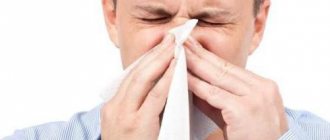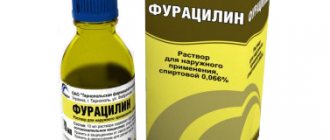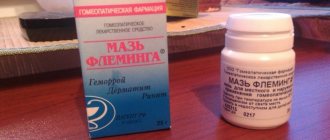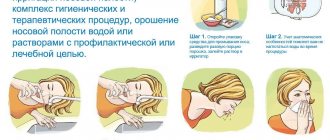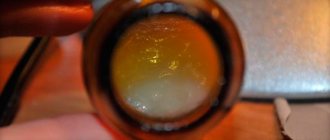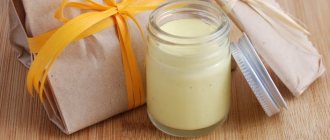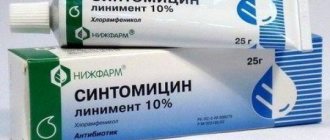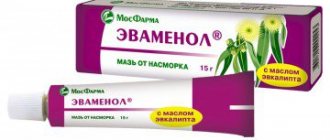What is a sore in the nose called?
The concept of sores is different for everyone. Some people call it dry crusts that interfere with breathing; For others, it’s acne caused by a cold. This definition includes:
- cracks that appear on the outer part of the nasal passage most often appear with prolonged rhinitis;
- boils - dense purulent cavities protruding above the skin;
- crust during healing - they look like sores in the nose, covered with a rough crust;
- erosion (ulcer) - sores that have a small depression filled with pus;
- eczema, consisting of crusts and spots with scales covering them.
Causes of sores and their symptoms
There are many reasons for the appearance of sores inside the nose. Some of them are not associated with diseases. The most common is a viral infection. The mucous membrane dries out, crusts form on it, causing discomfort - it is too tender, any mechanical actions can cause bleeding and the appearance of sores. But there are other diseases that can result in them:
- Herpes virus. After the body is damaged by a pathogenic agent, bubbles form inside the nose. Over time, they burst, causing crusts to form. They itch and cause discomfort. If herpes appears too often, you should consult your doctor. There may be problems with the immune system.
- Furunculosis. With this pathology, swelling appears, which leads to difficulty in nasal breathing. The mucous membrane begins to ache, turn red, and purulent formations appear. Do not press them on your own - this often leads to complications.
- Allergy. With constant exposure to allergens, wounds appear on the mucous membrane: they itch, bleed, and take a long time to heal, causing discomfort. If you do not get rid of the source of the allergy, such sores may appear in other parts of the body.
- Polyps. Formed when the mucous membrane grows excessively. The sores are very itchy. The main symptom is problems with nasal breathing, decreased clearance of the passages.
- Sycosis. With this disease, pathogenic microorganisms cause an inflammatory process in the hair follicles. When the disease is advanced, pus appears.
- Erysipelas. A pathological condition affecting not only the nasal passages, but also the entire pharyngeal cavity. When an injury becomes infected, the inflammatory process begins to move deeper into the tissue.
- Syphilis. The first sign is the appearance of a painful chancre. If left untreated, the lesion affects bone tissue.
- Tumor processes. The presence of a painful ulcer that does not go away for a long time may indicate the growth of a tumor.
Symptoms depend on the cause that caused the sores:
- with a boil, the temperature rises, the nose hurts, the skin around the pimple turns red, and if left untreated, the lymph nodes may become enlarged;
- with erysipelas, the skin of the nose turns red, begins to hurt very much, chills appear, and symptoms of intoxication may be observed;
- When you have an allergy, a rash appears - it is very itchy, causing discomfort.
Sores can appear as a result of mechanical damage or uncontrolled intake of vasoconstrictor drops.
How does the disease manifest itself?
When the pathological process is accompanied by damage to the tissue of the lips on the outside (skin, red border) and is inflammatory in nature, it is called cheilitis. This is the most common situation that can be addressed to a dermatologist. Damage to the mucous membrane can also be classified as stomatitis, especially if other areas of the oral cavity are also affected.
READ ALSO: Japanese soap for face and body - buy ALL-J soap (Japan)
Aphthous stomatitis
Very often in a doctor’s practice one has to deal with stomatitis, in which erosions form on the mucous membrane, covered with a gray fibrinous coating - aphthae. First, a small focus forms - a red spot on the inside of the lips or a transitional fold, but soon typical defects form, spreading to the lateral surfaces of the tongue. Stomatitis is also accompanied by subjective symptoms:
- Burning.
- Soreness.
- Salivation.
- Difficulty eating and speaking.
In the necrotic form of stomatitis, the previously formed aphthae deepen, transforming into ulcers. A distinctive feature is that the defects are characterized by mild pain. Their epithelization can take up to a month.
Herpetic infection
The prevalence of herpes infection is very wide - the majority of the population is infected with the corresponding viruses. The lip area is a favorite location for herpes simplex (labial). When small bubbles pop up there, this is what they often mean. An exacerbation of herpetic infection is usually observed after hypothermia, acute respiratory viral infection, or during menstruation in girls.
Before the appearance of vesicles, a burning sensation and itching is felt, redness and slight swelling occur. After some time, raised elements form on the lip - vesicles filled with serous contents. Very quickly their tire bursts with the formation of weeping erosion. Damage heals with the formation of crusts, leaving no traces behind.
Many people have probably experienced the signs of a herpes infection. Blisters on the lips are its typical manifestation.
Candidiasis
Having noticed a white coating on the inside of the lips, one cannot help but think about such a common condition as thrush. Yeast-like bacteria from the genus Candida are opportunistic microbes, but when the protective properties of the mucous membrane decrease, they multiply there and provoke inflammation.
Candidal cheilitis is accompanied by redness of the mucous membrane and the appearance of a whitish coating on it. The latter looks like a film or has a curd-like consistency, often located on the inner surface of the lower lip. The plaque is easily removed, but underneath, especially with severe candidiasis, the surface becomes covered with erosions. Among the subjective symptoms, patients are concerned about:
- Feeling dry.
- Burning and soreness.
- Viscosity of saliva.
Thrush usually occurs in a mild form. However, in patients with immunodeficiencies, oral candidiasis is combined with damage to the pharynx and even the esophagus; the disease recurs and is difficult to correct.
Pustular diseases
Pyoderma is another group of diseases that can cause manifestations on the lips. Usually an abscess appears on the outside, but there are also elements on the side of the mucous membrane (for example, with secondary infection of aphthae). Since hair follicles are present on the skin in this area, especially in men, clinical variants of pyoderma may include:
- Ostiofolliculitis.
- Sycosis.
- Furuncle.
These are diseases of staphylococcal nature, but there is also a pathology caused mainly by streptococci - impetigo. The first are accompanied by the formation of pustules or pustules around the hair follicle, which is observed against the background of local redness and swelling. With sycosis, multiple elements merge into a continuous bumpy surface with yellowish crusts.
Streptoderma occurs with elements of a different type - conflicts. These are bubbles with a flabby tire, inside of which there is pus. They have nothing to do with hair, and therefore there is a layer of healthy skin between the individual conflicts. However, purulent elements also tend to spread and merge, forming ring-shaped impetigo. A similar situation is often found in children.
Pustules on the lips are formed under the influence of bacterial flora. They look like cone-shaped nodules around the hairs or bubbles with cloudy contents.
Blistering dermatoses
When cavitary elements with transparent contents and a thin covering form on the skin of the lips, but not herpes, then one has to think about blistering dermatoses. This is a group of diseases characterized by a different course, but the same type of rash.
READ ALSO: How to remove wen on the face - home use recipes
With pemphigus, the elements of the rash are represented by blisters, which very quickly open to form oval erosions. The first to be affected is the mucous membrane of the mouth and lips. The defects are located against the background of unchanged mucosa and are bordered along the periphery by fragments of epithelium. When you pull on the edge of the tire, further peeling occurs (Nikolsky's symptom).
Dühring's dermatitis herpetiformis is accompanied by the formation of not only blisters, but also papules, pustules, and blisters, which are located against the background of reddened epithelium. The mucous membrane of the oral cavity, including the lips, is affected less frequently than with pemphigus, and never precedes the formation of a rash on the body. Nikolsky's symptom is always negative.
Leukoplakia
Unlike inflammatory processes, leukoplakia is a condition of a tumor nature, the development of which is associated with para- and dyskeratosis (impaired keratinization of the epithelium). It can be assumed if a white spot appears on the outside of the lower lip, in the area of the red border, but does not extend to the skin. Usually it does not bring subjective discomfort.
Flat leukoplakia also affects the mucous membrane of the anterior cheeks with transition to the lips. Then the lesions acquire a triangular shape, with their apex facing the teeth. This process may be accompanied by a feeling of tightness, dryness, burning, and a change in taste.
If leukoplakia turns into a verrucous form (plaque or warty), then the spots transform into raised formations. They bring additional discomfort and often bite. Erosive leukoplakia is characterized by painful defects of the epithelium. It is she who most often undergoes malignant transformation.
Folk remedies for nasal sores
If the sores are not painful, there are only a small number of them, you can try to use proven methods - folk remedies, they are effective and safe. The only caveat is that it will not be possible to cure sores in the nose if you have an infectious disease or eczema. Treatment will be symptomatic. Regardless of the product you choose, you should first rinse your nose. To do this, it is better to use saline solution or Furacilin.
Inhalations
woman keeping inhale mask
Helps moisturize the mucous membrane, which promotes the rapid removal of crusts, soothes and relieves inflammation. It is best to carry out inhalations with the help of calendula and celandine. They have an anti-inflammatory effect.
Instructions:
- Pour water over the herbs and bring to a boil in a water bath.
- Remove from the stove.
- Bend over the container and cover your head with a towel.
- Breathe steam for 10 minutes.
Garlic
Garlic oil is a natural antibiotic, antiseptic, and helps fight fungus. Take 2 heads of garlic, peel and chop. Pour 400 ml of oil into the mixture and leave it in a dark place for 2 weeks. Use a cotton swab to lubricate the nasal passages up to 4 times a day.
Sea buckthorn
Sea buckthorn oil has a wound-healing effect, quickly restores the mucous membrane, and relieves inflammation. They act in a similar way: lubricate the passages with a cotton swab dipped in oil or insert it into the nose for half an hour.
Sulfur
This is one of the most accessible methods of getting rid of - how to get rid of sores in the nose as quickly as possible with minimal cost. To do this, you need matches: moisten the head and pass it over the affected areas. A similar procedure should be performed 1-2 times a day. As a result, even long-healing sores quickly disappear.
Calendula
Calendula oil has a quick anti-inflammatory effect. It’s easy to make: fill a 0.6 liter jar with dry raw materials, fill it with oil and place in a water bath for 2 hours. After this, the composition is infused for 24 hours, and the nasal passages are lubricated with the product 2 times a day.
Medicinal infusion
The medicinal infusion will strengthen the immune system, which will help maintain the body's defenses and fight viruses and bacteria. To prepare it, take 30-40 g of raspberries and juniper berries, oregano, mint leaves, and thyme. Take 1 tsp. composition, pour 180 ml of boiling water and leave for half an hour. To improve the taste, you can add 2 tsp. honey
Honey and onions
Take 1 tbsp. onion juice, 0.5 tsp. honey and 30 ml of water. All components are mixed and used as nasal drops, instilling 1 drop into each nasal passage up to 5 times a day. This ointment can cause allergies or burns, so it should be used with caution.
Treatment
Therapeutic tactics are determined by the nature of the pathology identified during the examination. Only a doctor can make a diagnosis and determine which methods will be the most effective to solve the problem. In addition to specific correction, general measures also play a significant role:
- Mechanically, thermally and chemically gentle food (ground, without spicy food, at a comfortable temperature).
- Avoiding contact with allergens.
- Quitting alcohol and smoking.
- Compliance with personal hygiene rules.
- Careful oral care.
- Removal of dissimilar metals in prostheses, their processing, etc.
To increase the body's resistance, it is recommended to take multivitamins, eat well and lead a healthy lifestyle. It is also necessary to promptly treat concomitant pathologies that have a negative impact on immune reactivity.
How to treat an ulcer?
Erosion and ulcers require elimination of the causative factor (primarily infectious), cleansing of defects, acceleration of healing processes and alleviation of symptoms. The following medications are used for this:
- Antiseptics (hydrogen peroxide, furatsilin, chlorhexidine, citral).
- Local anesthetics (anesthesin, lidocaine, novocaine).
- Proteolytic enzymes (trypsin, chymotrypsin).
- Corticosteroids (hydrocortisone).
- Reparants (Solcoseryl, Actovegin).
- Vitamins (retinol, tocopherol).
READ ALSO: Why may red and white bumps appear on the tongue near the throat?
In addition to external drugs, antihistamines (Tavegil, Zyrtek, Suprastin), antibacterials (metronidazole, penicillins), immunomodulators, and sedatives are used in treatment. Physiotherapy in the form of electro- and phonophoresis and laser therapy are combined with drug correction.
Ulcerative defects and erosions of the mucous membrane require active and comprehensive correction under the guidance of a physician.
How to get rid of an abscess?
Superficial pyoderma can only be treated with external means. For this purpose, the lesions are treated with various antiseptics:
- Diamond green.
- Boric alcohol.
- Fukortsin.
They treat both a ripening abscess on the skin and an opened one. But alcohol solutions are not used to treat mucous membranes - water- or oil-based preparations (chlorophyllipt, chlorhexidine, furatsilin) are needed. After the pus has drained, the elements are treated with antibacterial ointments (erythromycin, lincomycin) and liniments (chloramphenicol, synthomycin).
Common forms of pyoderma require systemic antibacterial therapy with penicillins (Ampiox, Augmentin), macrolides (Sumamed), cephalosporins (Klaforan, Cefobid), fluoroquinolones (Tsiprolet). Therapy regimens also contain drugs that increase immunity to bacterial pathogens - staphylococcal plasma, bacteriophage, toxoid, vaccine, gamma globulin.
The most effective ointments against nasal sores
Let's consider what to do if traditional methods do not help with a sore in the nose, rather than treating them at home. Special ointments will help here, which should be prescribed by a doctor depending on the cause of the unpleasant symptom and the severity of the disease.
Antibacterial ointments contain antibiotics. They are prescribed if the cause of the sores is a bacterial infection. The products help reduce inflammation, prevent secondary accumulation of bacteria, and restore breathing. There are classic antibacterial ointments: Levomekol, Tetracycline and Levomycetin, and antiseptics, for example Miramistin, Bactroban.
The latter are considered more universal and effective: Bactroban ointment is used as a local antimicrobial agent. Destroys bacteria, reduces the rate of their reproduction. Contraindications for use include individual intolerance to the components of the composition. Miramistin ointment is indicated for use in the treatment of viral and bacterial infections. The drug has virtually no contraindications.
If sores appear due to viral infections, antiviral ointments are prescribed. The most effective are Viferon and Infagel. They not only inhibit the development of viruses, but also have an immunostimulating effect. Such drugs have more contraindications: heart and vascular diseases, cirrhosis of the liver. Another remedy is Oxolinic ointment, which has an antiviral effect. Blocks the development of microorganisms.
If there is a herpes virus, antiherpetic ointments, such as Acyclovir, are prescribed. Their use reduces the risk of spreading the virus and speeds up the healing process of scabs. Combination medications may also be prescribed. They have a number of actions:
- immunomodulatory;
- restorative;
- antihistamine.
Ointments relieve inflammation and inhibit the development of microorganisms and viruses. The most popular products in this group are Doctor Mom, Pinosol, hydrocortisone ointment, Triderm. If the ointment contains menthol or eucalyptus, they cannot be used in case of individual intolerance, when treating children under 2 years of age - this can lead to complications.
Homemade ointments are also popular. They can be used if the causes of the sores do not pose a threat to health. Aloe-based ointment helps eliminate dryness. It relieves inflammation and has an antiseptic effect. To prepare it, mix 5 ml of aloe juice with 50 g of petroleum jelly, add 2 drops of eucalyptus oil. Cotton pads are moistened with the composition and placed in the nasal passages for 5 minutes.
Another option is ointment with lanolin. Prevents drying out, disinfects, eliminates dry crusts. To prepare, take 40 g of lanolin, 5 ml of olive oil, 2 drops of calendula tincture, mix.
How to quickly get rid of ulcers in children depends on the chosen ointment:
- to restore the mucous membrane, Bepanten is prescribed;
- for infections that are accompanied by the release of pus, Miramistin is suitable;
- to reduce the inflammatory process in the mucous membranes - Viferon.
It is important to constantly monitor the progress of therapy, contacting your pediatrician if complications, allergies, or other unpleasant symptoms occur.
Treatment of trophic ulcers
How to treat trophic ulcers on the legs in older people? There are no special procedures, approaches or specific drugs for recovery. Methods of combating the disease are different in each specific case and are selected based on the causes of ulcers, general health, age, and the like.
To start treatment, you need to visit a phlebologist. He will determine the type of disease, prescribe a diagnosis and rehabilitation course.
Laboratory research is carried out in the following areas:
- Bacteriological
- Cytological
- Histological
If necessary, the doctor may conduct other tests. This is what will help in establishing the causes, making a diagnosis and carrying out treatment procedures. Recovery can be of five types:
- With the help of medications
- Surgery
- Local
- Physiotherapeutic
- Recovery using traditional medicine
- Medicines used for treatment
Medicines in the treatment of such a disease are used in combination with local procedures . They include removal of dead tissue, exudate, disinfection and application of medications. There are no special drugs to heal such wounds. But doctors often prescribe anti-inflammatory, restorative, antibiotic, painkillers and thrombus-absorbing ointments.
They are applied at least twice a day to the affected skin, after disinfecting the wound. The most commonly prescribed drugs are:
- Erythromycin ointment is an antiseptic. Used for purulent and inflammatory lesions. Does not lead to addiction or poisoning of the body. The recovery course can last 4 months.
- Venoruton - prevents the formation of clots and inflammatory foci, strengthens vascular walls, improves blood supply. The drug is available in a gel-like form. Lyoton or Troxevenol can be used as analogues.
- Synthomycin ointment is an antibacterial medicine. Has a significant anti-inflammatory effect.
- Solcoseryl - exists in the form of ointment and gel. Improves tissue metabolic processes, oxygen supply and skin restoration.
- Levomekol is a disinfectant ointment. In addition, it restores and heals wounds, improves local immunity, has an anti-inflammatory effect and relieves pain. Levomekol is allowed for short-term use. It is applied to sterile flaps and applied to the affected areas once a day.
- Betadine is an iodine-containing ointment. Affects fungi, bacteria and viruses. The ointment gives positive results on the fifth day of use.
- Tetracycline ointment is an antibiotic agent. Use twice a day by applying to the wound or applying sterile wipes with ointment.
There are a lot of options for such drugs. They are selected by a doctor because many of them have contraindications and side effects. In addition, each of them affects a certain type of microflora, which is individual for each patient.
Surgical treatment of ulcers
The method of surgical treatment is based on the removal of areas of inflammation and dead tissue. There are the following methods:
- Curettage
- Vacuum therapy
- Caterization
- Virtual amputation
- Amputation
The last method is the most radical; it is carried out in cases where it is not possible to preserve the integrity of the limb.
Also, in particularly difficult cases, transplantation of healthy skin from the thighs or buttocks may be prescribed. This method ensures healing thanks to new skin cells.
Other methods are aimed at removing purulent exudate, dead tissue and inflammatory foci. After surgery, a course of medication must be prescribed.
Drug treatment, its stages and goals
Treatment of trophic ulcers in the first stages is carried out using diclofenac, ketaprofen, antihistamines, injections of reopoglukin, pintoxifyline. Furacilin or chlorhexidine are prescribed as antiseptics.
Chamomile decoction can be used as a traditional medicine.
When the wound begins to heal and scar, ointments with a healing effect are prescribed.
The last stage of treatment is the relief of the disease, which led to the formation of trophic wounds.
Compression in this disease:
Each stage of treatment is accompanied by fixation of the wound with a multilayer elastic bandage or special stockings. Thanks to this, venous diameter and swelling are reduced, blood and lymph circulation improves.
This method is used in conjunction with the main ones. It is prescribed when wounds begin to heal and scar. Thanks to low-frequency ultrasonic cavitation in the Kravchenko pressure chamber, the effect of antiseptics on the microflora that develops in the ulcer is improved.
Why sores constantly form, reasons for relapses
If sores pop up regularly in your nose, this may indicate a chronic infection. This happens if the treatment was incorrect or the course of prescribed therapy was not completed completely. As a result of this, the infection becomes more stable, microbes quickly grow and multiply, which leads to relapses
You cannot do without visiting a specialist: you need to get tested, after which the doctor will select other medications. It is important for the patient to strictly follow all recommendations in order to get rid of relapses and avoid complications. The constant appearance of sores may indicate other problems in the body.
Thus, if the digestive tract malfunctions, problems with the mucous membrane and skin may occur; Diabetes mellitus is manifested by the appearance of itching and inflammatory elements in the nose. The microclimate is also important: if the air is dry, microbes on the dried mucous membrane develop faster, which becomes the cause of sores.
Prevention of inflammation in the nose
Vitamin B. Capsules B1 B2 B6 B12 on white isolated background.
3d The main cause of nasal ulcers is infection. For this reason, experts recommend:
- during periods of epidemics of colds, strengthen the immune system;
- use ointments to protect the mucous membrane;
- after returning from the street, rinse the nasal passages with saline solution or calendula tincture;
- in spring and autumn, drink a vitamin-mineral complex;
- do not forget about rest and sleep mode.
It is also important to protect your nose from mechanical damage and consult a doctor if the sores that appear do not go away for a long time. This will protect you from possible consequences.
